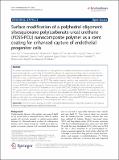Surface modification of a polyhedral oligomeric silsesquioxane poly(carbonate-urea) urethane (POSS-PCU) nanocomposite polymer as a stent coating for enhanced capture of endothelial progenitor cells
Author(s)
Tan, Aaron; Farhatnia, Yasmin; Goh, Debbie; G, Natasha; de Mel, Achala; Lim, Jing; Teoh, Swee-Hin; Malkovskiy, Andrey V; Chawla, Reema; Rajadas, Jayakumar; Cousins, Brian G; Alavijeh, Mohammad S; Seifalian, Alexander M; Hamblin, Michael R.; ... Show more Show less
Download1559-4106-8-23.pdf (5.028Mb)
PUBLISHER_CC
Publisher with Creative Commons License
Creative Commons Attribution
Terms of use
Metadata
Show full item recordAbstract
An unmet need exists for the development of next-generation multifunctional nanocomposite materials for biomedical applications, particularly in the field of cardiovascular regenerative biology. Herein, we describe the preparation and characterization of a novel polyhedral oligomeric silsesquioxane poly(carbonate-urea) urethane (POSS-PCU) nanocomposite polymer with covalently attached anti-CD34 antibodies to enhance capture of circulating endothelial progenitor cells (EPC). This material may be used as a new coating for bare metal stents used after balloon angioplasty to improve re-endothelialization. Biophysical characterization techniques were used to assess POSS-PCU and its subsequent functionalization with anti-CD34 antibodies. Results indicated successful covalent attachment of anti-CD34 antibodies on the surface of POSS-PCU leading to an increased propensity for EPC capture, whilst maintaining in vitro biocompatibility and hemocompatibility. POSS-PCU has already been used in 3 first-in-man studies, as a bypass graft, lacrimal duct and a bioartificial trachea. We therefore postulate that its superior biocompatibility and unique biophysical properties would render it an ideal candidate for coating medical devices, with stents as a prime example. Taken together, anti-CD34 functionalized POSS-PCU could form the basis of a nano-inspired polymer platform for the next generation stent coatings.
Date issued
2013-08Department
Harvard University--MIT Division of Health Sciences and TechnologyJournal
Biointerphases
Publisher
Springer-Verlag
Citation
Tan, Aaron et al. “Surface Modification of a Polyhedral Oligomeric Silsesquioxane Poly(carbonate-urea) Urethane (POSS-PCU) Nanocomposite Polymer as a Stent Coating for Enhanced Capture of Endothelial Progenitor Cells.” Biointerphases 8.1 (2013): 23.
Version: Final published version
ISSN
1559-4106
1934-8630